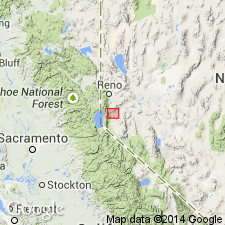
- Usage in publication:
-
- Eureka Canyon Tuff*
- Modifications:
-
- Named
- Reference
- Dominant lithology:
-
- Tuff
- AAPG geologic province:
-
- Great Basin province
Summary:
Named for Eureka Canyon. Type section: exposures in Eureka Canyon, at common boundary between secs.32 and 33 T16N R21E New Empire quad, Lyon Co, NV. Formerly part of Hartford Hill Rhyolite Tuff (Gianella, 1936), now abandoned. Reference sections: 1) 1.4 mi northeast of Carson Airport NE 1/4 NW 1/4 sec.34 T16N, R20E, New empire 7.5' quad; 2) Duck Hill sec.30 T15N R20E, Carson City 7.5' quad. Consists of white to pale-gray, lavender, and tan rhyolite tuff. Described as vitric, with distinct cooling zonation, mostly devitrified, weakly welded with zones of vitrophyre and very uniform in primary texture and composition. Is about 130 m thick with range up to 150 m. In Carson City-Silver City area, is separated from underlying Nine Hole Tuff (new) by beds of boulder-size clasts; disconformably underlies younger Tertiary tuffs. Correlated with upper part of Bluestone Mine Tuff of Proffett and Proffett (1976) and with one of thin cooling units in tuff of Gabbs Valley (E.B. Ekren, written Commun., 1976) where K-AR age determinations on 2 sanidine samples yielded 26.1 +/-0.8 and 25.0 +/-1 Ma. Is Oligocene age.
Source: GNU records (USGS DDS-6; Menlo GNULEX).
For more information, please contact Nancy Stamm, Geologic Names Committee Secretary.
Asterisk (*) indicates published by U.S. Geological Survey authors.
"No current usage" (†) implies that a name has been abandoned or has fallen into disuse. Former usage and, if known, replacement name given in parentheses ( ).
Slash (/) indicates name conflicts with nomenclatural guidelines (CSN, 1933; ACSN, 1961, 1970; NACSN, 1983, 2005, 2021). May be explained within brackets ([ ]).

